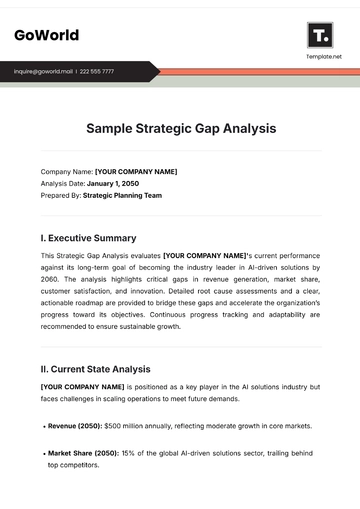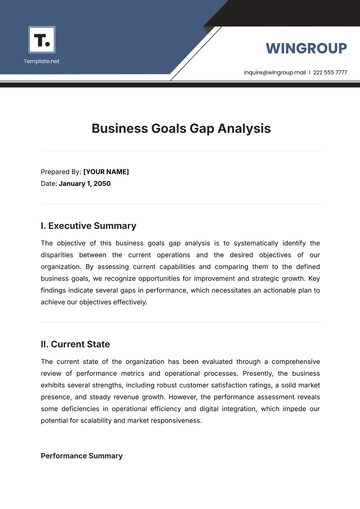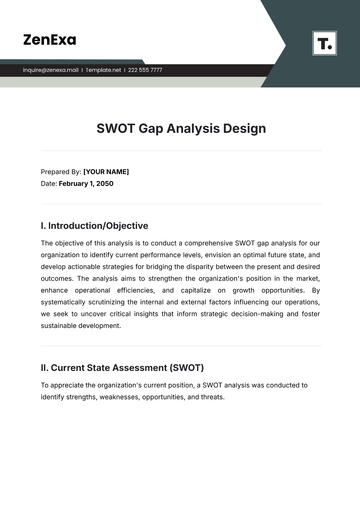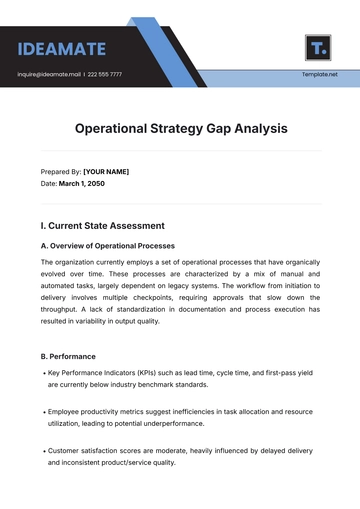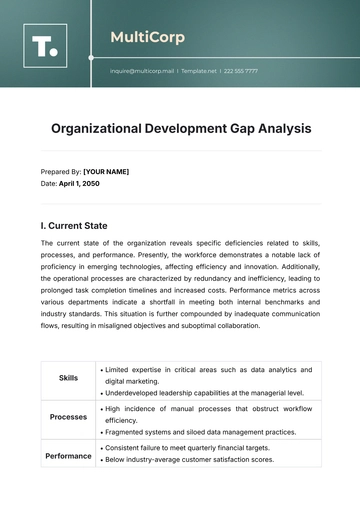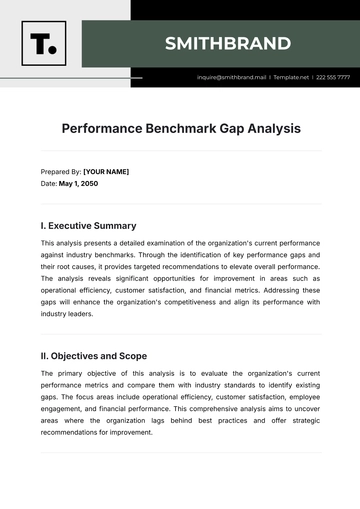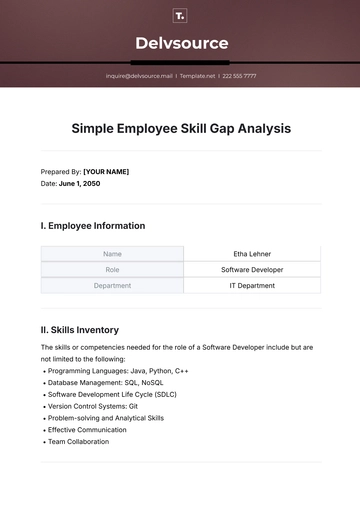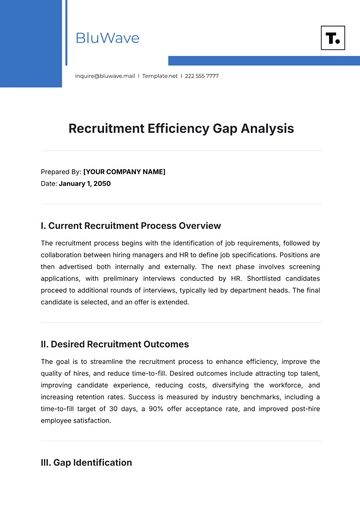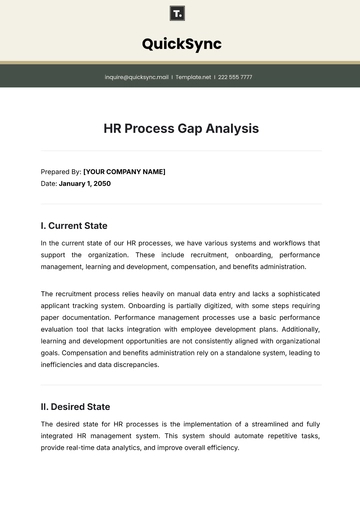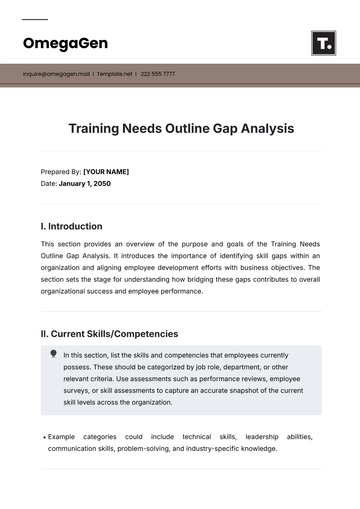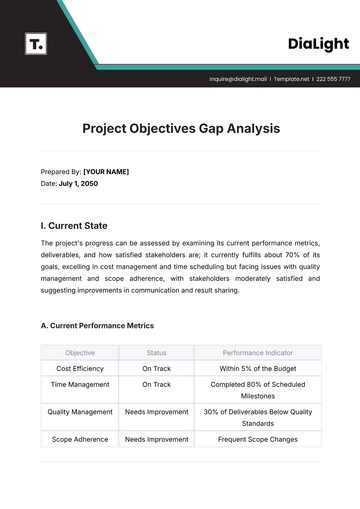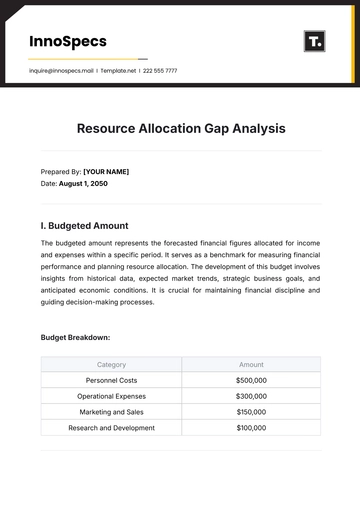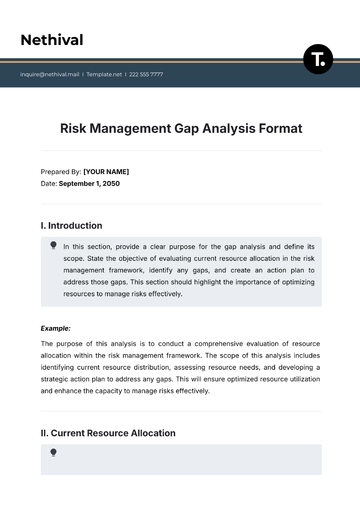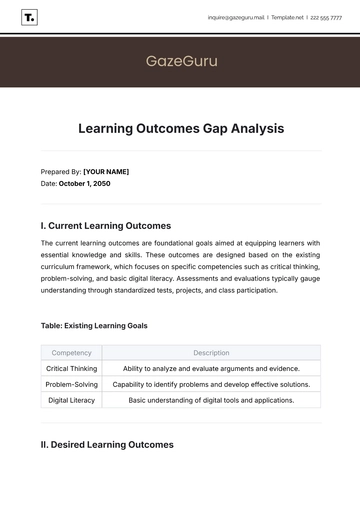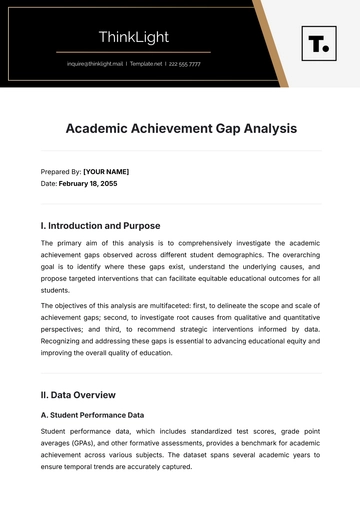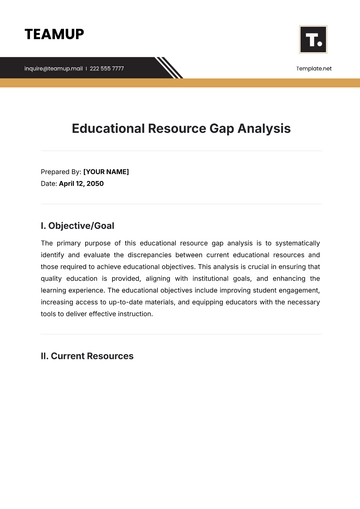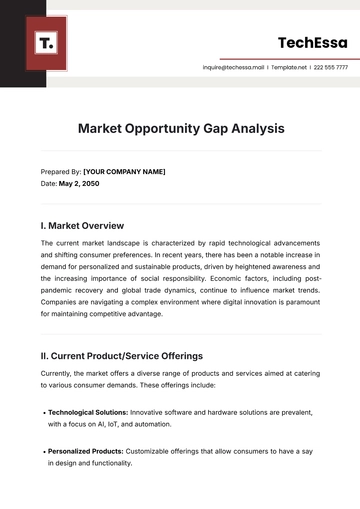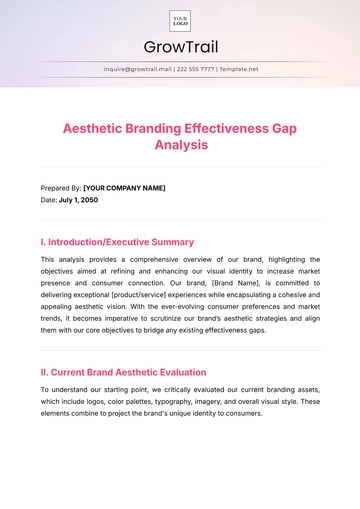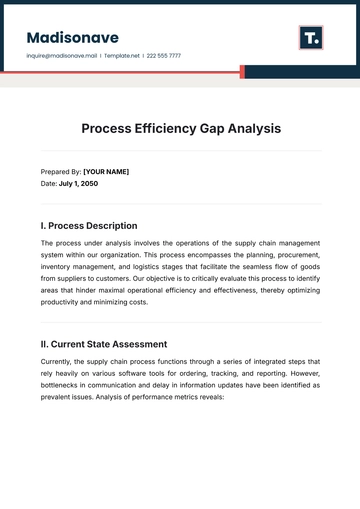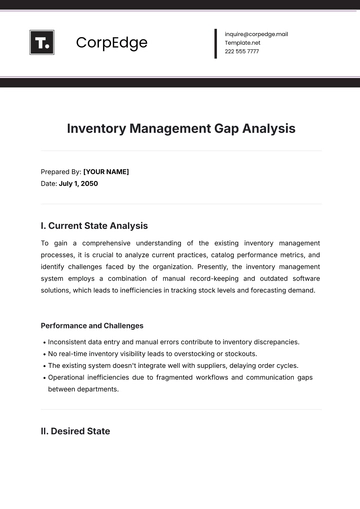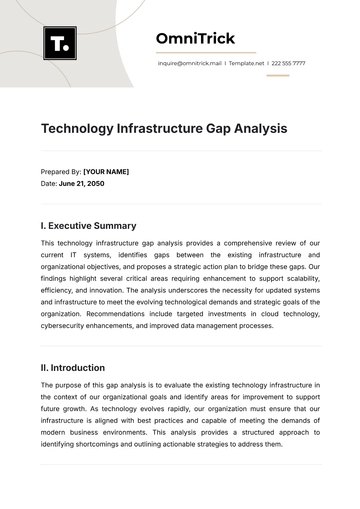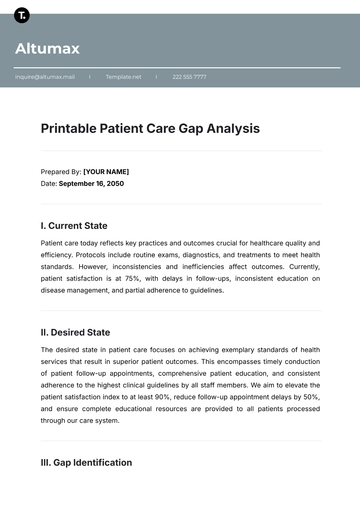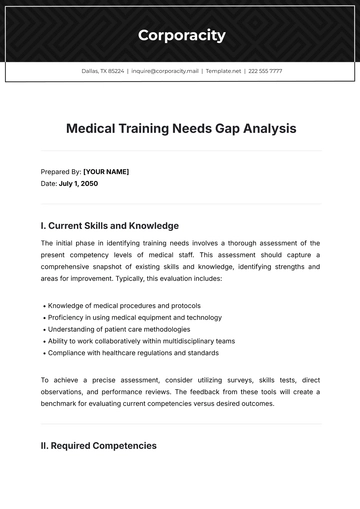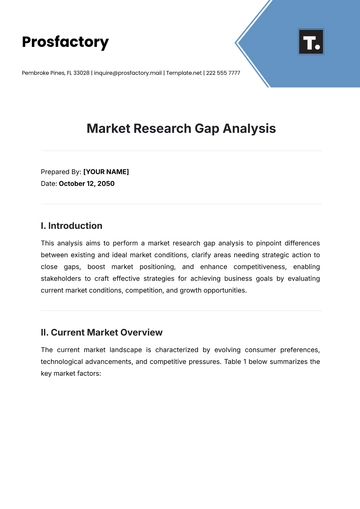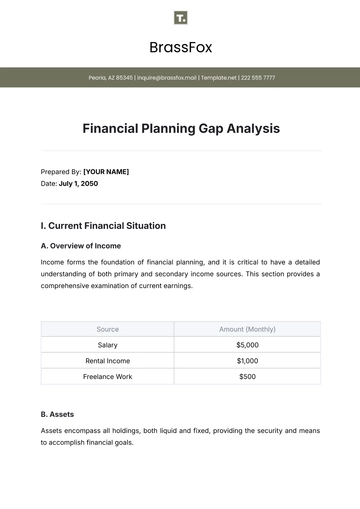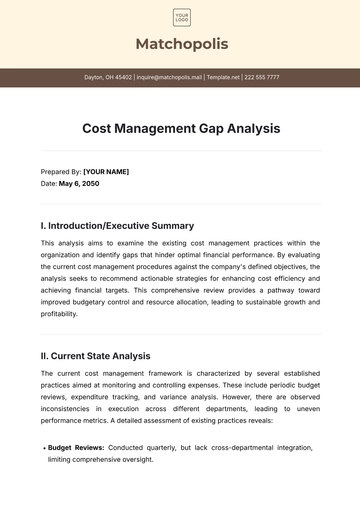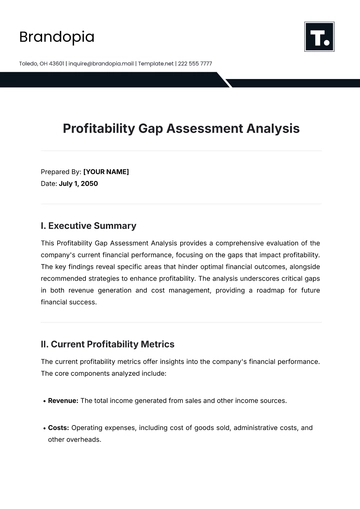Free Animal Care Analysis

I. Introduction
In 2050, animal care remains an essential focus for society due to the ongoing responsibilities in pet care, livestock management, conservation efforts, and wildlife rehabilitation. The purpose of this document is to provide a comprehensive analysis of the present state of animal care, covering various domains such as pet care, livestock welfare, wildlife preservation, and the regulatory and ethical considerations shaping the industry. The goal is to offer stakeholders an overview that will aid in developing sustainable, humane, and efficient animal care policies, practices, and solutions.
II. Objectives of the Animal Care Analysis
To provide an overview of current practices and innovations in animal care.
To assess key areas of concern and improvement in animal welfare and management.
To suggest actionable recommendations for [Your Company Name] to adopt and implement.
To analyze the economic and environmental impact of advancements in the field of animal care.
III. Scope
This analysis examines multiple sectors within animal care, including pet welfare, livestock management, wildlife conservation, and animal-assisted therapy. Emphasis will be placed on the societal role of animal care, technological advancements, economic impact, and ethical considerations. The scope extends globally, with data sourced from various countries to provide a comprehensive overview of global trends and practices.
IV. Key Areas of Animal Care
A. Pet Care and Welfare
1. Pet Ownership Trends
The number of pet owners is projected to increase by [20%] by the year 2050. This rise reflects growing human-animal companionship and increasing awareness of animal welfare. With this upward trend, it is essential to examine the quality of care that pets receive and address issues such as nutrition, exercise, mental stimulation, and veterinary care.
1.1 Pet Nutrition
Recent studies suggest that pet nutrition should be customized according to each animal’s specific needs, such as age, breed, and medical conditions. Nutrition research shows that the global pet food market will grow by [30%] by 2050, with organic and specialty diets leading this trend. High-quality pet food brands are incorporating ingredients that align with animal health, such as grain-free options, high-protein diets, and allergen-free recipes.
2. Veterinary Care Services
The demand for veterinary services has increased significantly due to advanced diagnostic and treatment options. Veterinary care encompasses a wide range of services including preventive medicine, emergency care, surgeries, and chronic disease management. The veterinary industry is expected to grow by [25%] by 2050, driven by technological advancements such as telemedicine, robotic surgeries, and AI-based diagnostics.
Veterinary Service | Growth Rate by 2050 (%) | Key Innovations |
|---|---|---|
Telemedicine | 40 | Virtual consultations |
Robotic Surgery | 35 | Minimally invasive surgery |
AI Diagnostics | 50 | Predictive analysis tools |
3. Mental and Emotional Health of Pets
Pets require mental stimulation and socialization to prevent behavioral issues. Behavioral therapies, enrichment toys, and environmental adjustments are increasingly common to support the mental well-being of pets. The pet mental health industry is anticipated to expand by [15%] annually, with products focusing on cognitive stimulation, anxiety reduction, and stress management.
B. Livestock Management and Welfare
1. Overview of Livestock Industries
The global livestock industry is projected to increase by [30%] by 2050 to meet rising food demands. This growth necessitates improved practices in livestock welfare, disease prevention, and sustainable farming. Many regions have adopted animal welfare standards, but enforcement and adherence to these guidelines remain inconsistent globally.
1.1 Animal Welfare Standards in Livestock Management
Animal welfare standards for livestock cover several dimensions: housing, feed, water quality, and overall living conditions. Research indicates that stress reduction methods in livestock environments, such as enriched housing and better handling practices, directly contribute to improved productivity and quality of products such as milk, eggs, and meat.
Welfare Standard | Compliance Rate (%) | Impact on Productivity |
|---|---|---|
Enriched Housing | 60 | Increased yield |
Humane Handling | 75 | Reduced stress responses |
Disease Control Measures | 80 | Improved health outcomes |
2. Technological Advancements in Livestock Management
Automation, robotics, and genetic research have enhanced livestock care. For example, automated feeding systems and robotic milking machines have improved feeding accuracy and reduced labor costs. Genetic advancements, such as selective breeding and disease-resistant livestock, further enhance productivity and reduce animal suffering. These technologies are projected to increase efficiency by [35%] across the industry by 2050.
C. Wildlife Conservation and Preservation
1. Threats to Wildlife
Wildlife species face numerous threats, including habitat loss, climate change, poaching, and pollution. As of 2050, the World Wildlife Fund estimates that [25%] of global wildlife species are at risk of extinction. This rate continues to accelerate due to unsustainable land use practices, pollution, and rising temperatures. Immediate action is required to curb these trends and protect biodiversity.
2. Conservation Initiatives
Conservation initiatives play a critical role in preserving endangered species and their habitats. Organizations and governments globally are investing in programs to restore natural habitats, enforce anti-poaching laws, and implement wildlife corridors. By 2050, it is anticipated that global investment in wildlife conservation will increase by [40%].
Conservation Effort | Projected Growth (%) | Expected Outcomes |
|---|---|---|
Habitat Restoration | 45 | Increased species diversity |
Anti-Poaching Measures | 60 | Reduced poaching incidents |
Wildlife Corridors | 35 | Enhanced genetic diversity |
3. Technological Innovations in Conservation
The integration of technology in wildlife conservation has opened new avenues for protecting and monitoring species. Key advancements include remote-sensing technology, satellite tracking, and drones for wildlife monitoring. These innovations offer real-time data on animal populations, migration patterns, and environmental changes, contributing to more effective conservation efforts. By 2050, technology-driven wildlife conservation is expected to reduce species monitoring costs by [20%].
D. Animal-Assisted Therapy
1. Growth of Animal-Assisted Therapy
Animal-assisted therapy (AAT) has been widely recognized for its therapeutic benefits, helping individuals with physical, emotional, and mental health challenges. AAT is utilized in hospitals, rehabilitation centers, and schools, where animals assist patients in managing stress, depression, and PTSD symptoms. By 2050, the use of AAT is expected to increase by [30%], reflecting growing societal acceptance and demand.
1.1 Benefits of Animal-Assisted Therapy
Animal-assisted therapy has shown to improve patient outcomes across diverse age groups and conditions. Interactions with animals have proven beneficial in reducing stress levels, improving mood, and promoting physical health. The expected increase in the use of AAT aligns with research showing that animals play an important role in both short-term and long-term health management strategies.
Patient Demographic | Benefits Observed | Growth Rate of AAT Adoption (%) |
|---|---|---|
Children | Reduced anxiety | 35 |
Elderly | Enhanced mood and social activity | 25 |
PTSD Patients | Lowered stress, improved coping | 40 |
2. Types of Animals in Therapy
The range of animals used in therapy has expanded beyond traditional dogs and horses to include small mammals, birds, and even aquatic species. Each animal offers unique therapeutic benefits, with different species suited to different types of therapy settings. For example, birds are often used in long-term care facilities to stimulate patient interactions, while equine therapy has proven effective in trauma recovery.
V. Economic Impact of Animal Care
The animal care industry’s economic impact is significant, with projections indicating a global market value of approximately $[500 billion] by 2050. This growth is attributed to the increased spending on pet care, the adoption of advanced veterinary services, and the demand for sustainable livestock management practices.
A. Employment Opportunities in Animal Care
As the animal care sector expands, so does the demand for skilled professionals in veterinary care, animal training, rehabilitation, and wildlife conservation. Employment in the animal care sector is projected to grow by [22%] by 2050. This growth offers numerous job opportunities for veterinarians, animal behaviorists, conservationists, and other specialists, contributing positively to the global economy.
B. Revenue Generation in the Pet Care Industry
The pet care industry alone is expected to account for approximately $[250 billion] of the global animal care market by 2050. This includes revenue from pet food, grooming, accessories, and veterinary services. The growth of premium and customized pet products reflects the industry's responsiveness to consumer demand for high-quality and tailored care solutions for their pets.
Industry Segment | Projected Revenue (2050) | Growth Rate (%) |
|---|---|---|
Pet Food | $200 billion | 30 |
Veterinary Services | $100 billion | 25 |
Accessories and Grooming | $50 billion | 20 |
VI. Ethical Considerations in Animal Care
A. Animal Rights and Welfare Regulations
There is a growing recognition of animals as sentient beings deserving protection from harm and exploitation. In 2050, it is expected that [85%] of countries globally will have implemented stricter animal welfare regulations, encompassing pet care, livestock management, and wildlife conservation. The push for humane treatment of animals has led to the adoption of legislation aimed at ensuring better living conditions for animals in all settings, whether as pets, livestock, or wildlife.
1. Animal Rights in Livestock Farming
The ethical considerations in livestock farming are an ongoing debate, particularly concerning factory farming practices. By 2050, it is expected that [50%] of meat production globally will transition towards more humane practices, such as free-range systems and lab-grown meat, reducing reliance on traditional factory farming models. The movement towards more ethical treatment of animals in farming is being driven by consumer demand for transparency in production processes, along with growing concerns about animal suffering.
Ethical Practice | Adoption Rate (%) | Potential Benefits |
|---|---|---|
Free-Range Farming | 40 | Improved animal welfare |
Lab-Grown Meat | 25 | Reduced environmental impact |
Antibiotic-Free Farming | 50 | Healthier livestock |
2. Animal Testing and Research
Animal testing remains a critical area where ethical concerns frequently arise, especially in the pharmaceutical and cosmetics industries. There is a growing push to reduce or replace animal testing with alternatives, such as in vitro methods, computer modeling, and human-derived cell lines. By 2050, it is anticipated that [60%] of global companies will adopt cruelty-free testing practices, marking a significant shift towards more ethical research methodologies.
B. Public Awareness and Advocacy
The awareness surrounding animal welfare has greatly increased, thanks to advocacy from non-governmental organizations (NGOs), public figures, and social media platforms. By 2050, a large portion of the global population is expected to have a strong understanding of the ethical issues surrounding animal care, including the importance of supporting cruelty-free products and services. This public awareness will drive more ethical consumer behaviors, influencing industry standards and regulations.
VII. Future Trends in Animal Care
A. Technological Innovations
As we approach 2050, technological advancements will continue to transform animal care, making it more efficient, effective, and humane. Among the key technologies shaping the future of animal care are:
1. Artificial Intelligence and Machine Learning
AI and machine learning are already being integrated into various aspects of animal care, from diagnostic tools in veterinary medicine to automated feeding and care systems for livestock. By 2050, AI is expected to play a major role in predictive health management, allowing for early disease detection in both pets and livestock, thereby improving outcomes and reducing costs associated with veterinary care and treatment.
2. Biotechnology
Biotechnology will continue to make significant strides in the treatment of animal diseases, the improvement of animal genetics, and the production of lab-grown meat. By 2050, biotechnology is expected to make up a considerable portion of the animal care industry, leading to innovations such as genetically modified animals resistant to disease, improved livestock productivity, and the reduction of reliance on traditional animal-based products.
3. Automation in Animal Care
The use of robotics and automation in animal care is becoming increasingly common, particularly in livestock farming. Robotic systems are being utilized for feeding, milking, cleaning, and even monitoring animal health. These innovations reduce labor costs and improve operational efficiency, which is expected to increase by [35%] by 2050, making animal care more sustainable and less resource-intensive.
Technology | Expected Impact by 2050 | Projected Adoption Rate (%) |
|---|---|---|
AI Diagnostics | Early disease detection | 50 |
Robotic Feeding Systems | Increased feeding efficiency | 45 |
Lab-Grown Meat Production | Reduced environmental impact | 40 |
B. Sustainable Practices in Animal Care
Sustainability will be a cornerstone of animal care practices in the future, particularly in relation to livestock farming and the pet care industry.
1. Sustainable Pet Care Products
The pet care industry will increasingly focus on sustainability, with products like biodegradable pet waste bags, eco-friendly grooming supplies, and sustainable pet food packaging becoming more common. By 2050, it is projected that [60%] of pet care products will be eco-friendly, driven by consumer demand for green alternatives and reduced environmental impact.
2. Eco-Friendly Farming Practices
Livestock farming, historically a major contributor to greenhouse gas emissions, is expected to undergo significant changes by 2050. Sustainable farming practices such as rotational grazing, integrated crop-livestock systems, and regenerative agriculture are expected to become standard, contributing to reduced carbon footprints and better overall environmental outcomes. It is predicted that [40%] of global farms will adopt these practices by 2050.
Sustainable Practice | Adoption Rate (%) | Environmental Impact |
|---|---|---|
Regenerative Agriculture | 35 | Increased soil health |
Integrated Crop-Livestock Systems | 40 | Reduced emissions |
Eco-Friendly Packaging | 60 | Reduced plastic waste |
VIII. Regulatory Landscape in Animal Care
A. Global Animal Welfare Standards
As the awareness of animal welfare grows, so too does the need for comprehensive global standards and regulations. By 2050, the international community is expected to establish unified animal welfare standards, addressing various aspects of animal care, including the treatment of pets, livestock, and wildlife. These standards will provide clear guidelines for humane treatment, enforcement measures, and penalties for violations.
1. Local vs. Global Regulations
While international guidelines for animal welfare will become more consistent, local variations will still exist, taking into account the cultural, economic, and environmental factors of each region. Efforts are being made to harmonize these regulations through global agreements, ensuring that all animals—whether in homes, farms, or the wild—are treated humanely.
Region | Regulatory Focus | Expected Compliance Rate (%) |
|---|---|---|
North America | Pet care, livestock | 85 |
Europe | Wildlife conservation | 90 |
Asia-Pacific | Livestock farming | 70 |
2. Enforcement and Penalties
In response to the growing concern about animal welfare, enforcement mechanisms will become more robust, including increased surveillance, monitoring, and penalties for non-compliance. Governments and organizations will also invest in education and training programs to ensure that animal care professionals are equipped with the knowledge and skills to comply with these evolving standards.
IX. Conclusion
The future of animal care is closely intertwined with technological advancements, ethical considerations, and sustainability practices. As we move toward 2050, it is clear that a multifaceted approach will be required to ensure the welfare of animals across various sectors, including pets, livestock, wildlife, and those involved in therapy. At [Your Company Name], we remain committed to staying at the forefront of these developments, driving innovation in animal care practices, advocating for stronger regulations, and fostering a future where animals are treated with the care, respect, and dignity they deserve.
By focusing on humane treatment, sustainability, and technological innovations, we can meet the challenges of the future while creating a more ethical and sustainable world for animals.
References
World Animal Protection. (2050). "Animal Welfare and Ethics: A Global Perspective."
Global Livestock Initiative. (2050). "Advancements in Sustainable Animal Farming."
Pet Care Industry Report. (2050). "Growth and Innovations in the Global Pet Care Market."
Wildlife Conservation Organization. (2050). "State of Global Wildlife: Challenges and Solutions."
Animal Care Templates @ Template.net
- 100% Customizable, free editor
- Access 1 Million+ Templates, photo’s & graphics
- Download or share as a template
- Click and replace photos, graphics, text, backgrounds
- Resize, crop, AI write & more
- Access advanced editor
Evaluate and track the care provided with the Animal Care Analysis Template from Template.net. This editable and customizable template helps you assess animal health, behavior, and progress. Personalize it using our Ai Editor Tool for each animal’s specific needs.

